Uncategorized
Crypto Daybook Americas: LIBRA Fallout Weighs on Crypto Markets While FTX Repayments Are Set to Start

By Francisco Rodrigues (All times ET unless indicated otherwise)
While bitcoin (BTC) is little changed over the past 24 hours, down just 0.7%, the broader market is in a bearish mood following the Libra token debacle, which has led to accusations of fraud and calls for the impeachment of Argentina’s President Javier Milei.
The CoinDesk 20 Index is down around 2.3% over the past day, and the near- to medium-term market movement probably hinges on how the U.S.-Russia negotiations in Riyadh go. The talks are focusing not only on ending the conflict in Ukraine, but also on “normalization” of ties between the countries.
An additional layer of uncertainty comes from FTX Digital Markets, the Bahamas-based subsidiary of FTX, which starts repaying creditors today. In total, FTX’s repayment program will be around $16 billion.
The liquidity injection will come in the form of stablecoins. First up are creditors with claims under $50,000, who will receive roughly 119% of their adjudicated claim value, with 9% annual interest accrued since November 2022.
The effect the repayments will have is unclear. While some analysts say the amount being repaid now is “too small to move the needle,” others suggest that FTX’s historic interest in the Solana ecosystem means some of these funds will flow toward it.
Investors have recently turned their attention to ether. U.S.-listed spot ETFs offering exposure to the second-largest cryptocurrency by market capitalization are seeing a cumulative net inflow of $393 million this month. That compares with a net outflow of $376 million for spot bitcoin ETFs.
These inflows come ahead of Ethereum’s Pectra upgrade entering its testing phase on the Holesky testnet. Pectra should bring a number of improvements to scalability and security and will let users pay for gas fees with tokens other than ether.
Elsewhere, individual investors are bearish amid trade-war threats, reduced interest-rate cut expectations, and consistent inflationary surprises. A survey from the American Association of Individual Investors found that bearishness among investors is at a two-year high, the Wall Street Journal reports.
This pessimism, however, is often a contrarian indicator. Institutional investors’ risk appetite has also dropped this month over the potential effects of a potential trade war amid the lowering odds of a Fed rate cut. Stay alert!
What to Watch
Crypto:
Feb. 18, 10:00 a.m.: FTX Digital Markets, the Bahamas-based subsidiary of FTX, will start reimbursing creditors.
Feb. 19: High-performance blockchain Monad’s public testnet starts up.
Feb. 19, 11:00 a.m.: The first official State of Sei (SEI) livestream.
Feb. 19, 1:00 p.m.: Hedera (HBAR) mainnet upgrade to v0.58.
Feb. 21: TON (The Open Network) becomes the exclusive blockchain infrastructure for messaging platform Telegram’s Mini App ecosystem.
Feb. 24: At epoch 115968, testing of Ethereum’s Pecta upgrade on the Holesky testnet starts.
Macro
Feb. 18, 10:20 a.m.: San Francisco Fed President and CEO Mary C. Daly delivers a speech in Phoenix. Livestream link.
Feb. 18, 1:00 p.m.: The Fed’s Michael S. Barr took, vice chair for supervision, gives a speech titled «Artificial Intelligence in the Economy and Financial Stability» in New York. Livestream link.
Feb. 19, 2:00 p.m.: The Fed releases minutes of the Jan. 28-29 FOMC Meeting.
Earnings
Feb. 18: CoinShares International (CS), pre-market
Feb. 18: Semler Scientific (SMLR), post-market
Feb. 20: Block (XYZ), post-market, $0.88
Feb. 24: Riot Platforms (RIOT), post-market, $-0.18
Feb. 25: Bitdeer Technologies Group (BTDR), pre-market, $-0.53
Feb. 25: Cipher Mining (CIFR), pre-market, $-0.09
Feb. 26: MARA Holdings (MARA), post-market, $-0.13
Token Events
Governance
Compound DAO is discussing evolving Compound Sandbox into Compound V4 to introduce streamlined governance, dynamic market parameters, enhance the liquidation mechanism, and improve cross-chain reward distribution.
Aave DAO is discussing expanding the AAVE governance token integration on the platform by adding AAVE collateral option to Base.
Uniswap DAO is discussing funding liquidity incentives for Uniswap V4 on the Unichain network to attract liquidity providers and traders to the protocol.
Unlocks
Feb. 21: Fast Token (FTN) to unlock 4.66% of circulating supply worth $78.6 million.
Feb. 28: Optimism (OP) to unlock 1.92% of circulating supply worth $34.23 million.
Token Launches
Feb. 18: Ethena (ENA) to be listed on Arkham.
Feb. 18: Ronin (RON) to be listed on KuCoin
Conferences:
CoinDesk’s Consensus to take place in Hong Kong on Feb. 18-20 and in Toronto on May 14-16. Use code DAYBOOK and save 15% on passes.
Day 1 of 3: Consensus Hong Kong
Feb. 23-March 2: ETHDenver 2025 (Denver)
Feb. 24: RWA London Summit 2025
Feb. 25: HederaCon 2025 (Denver)
March 2-3: Crypto Expo Europe (Bucharest, Romania)
March 8: Bitcoin Alive (Sydney, Australia)
Token Talk
By Francisco Rodrigues
Donald Trump supporters are set to receive around $50 worth of the official TRUMP tokens if they bought merchandise from the websites associated with the U.S. president.
The token was unveiled just days before Trump took office and have lost more than 70% of their value since then.
Solana-based decentralized exchange Jupiter has started accumulating USDC using 50% of the collected protocol fees to buy back JUP tokens. The buybacks haven’t yet started.
JUP’s price is down more than 12% over the last 24 hours over the protocol’s apparent involvement in the LIBRA cryptocurrency debacle.
Derivatives Positioning
SOL’s price may continue to fall, seeing that perpetual futures open interest has risen by 5% in the past 24 hours, accompanied by a negative cumulative volume delta (CVD). This combination indicates net selling pressure in the market.
The CVD for most major tokens is negative, indicating a bearish sentiment.
BTC and ETH front-dated or short-term puts continue to be pricier than calls on Deribit. The sentiment is bullish after February expiry.
Block flows featured an April expiry bitcoin bull put spread, involving strikes $85K and $100K and outright longs in puts at $94K and $90K strikes. Ether bull call spreads crossed the tape as well.
Market Movements:
BTC is down 0.69% from 4 p.m. ET Monday to $95,802.76 (24hrs: -0.57%)
ETH is down 2.88% at $2,698.31 (24hrs: -1.89%)
CoinDesk 20 is down 2.23% to 3,161.95 (24hrs: -3.03%)
Ether CESR Composite Staking Rate is up 27 bps to 3.18%
BTC funding rate is at 0.0078% (8.5541% annualized) on Binance
DXY is up 0.36% at 106.94
Gold is up 0.97% at $2,922.9/oz
Silver is up 0.70% to $32.99/oz
Nikkei 225 closed 0.25% at 39,270.4
Hang Seng closed +1.59% at 22,976.81
FTSE is up 0.18% at 8,783.43
Euro Stoxx 50 is unchanged at 5,520.7
DJIA closed Friday -0.37% at 44,546.08
S&P 500 closed unchanged at 6,114.63
Nasdaq closed +0.41% at 20,026.77
S&P/TSX Composite Index closed -0.84% at 25,483.2
S&P 40 Latin America closed +2.12% at 2,490.30
U.S. 10-year Treasury rate was up 3 bps at 4.51%
E-mini S&P 500 futures are up 0.1% to 6,151.5
E-mini Nasdaq-100 futures are up 0.21% at 22,282
E-mini Dow Jones Industrial Average Index futures are down 0.15% to 44,676
Bitcoin Stats:
BTC Dominance: 61.17 (0.85%)
Ethereum to bitcoin ratio: 0.02813 (-1.71%)
Hashrate (seven-day moving average): 790 EH/s
Hashprice (spot): $53.47
Total Fees: 6.93 BTC / $663,706
CME Futures Open Interest: 174,200 BTC
BTC priced in gold: 32.8 oz
BTC vs gold market cap: 9.31%
Technical Analysis
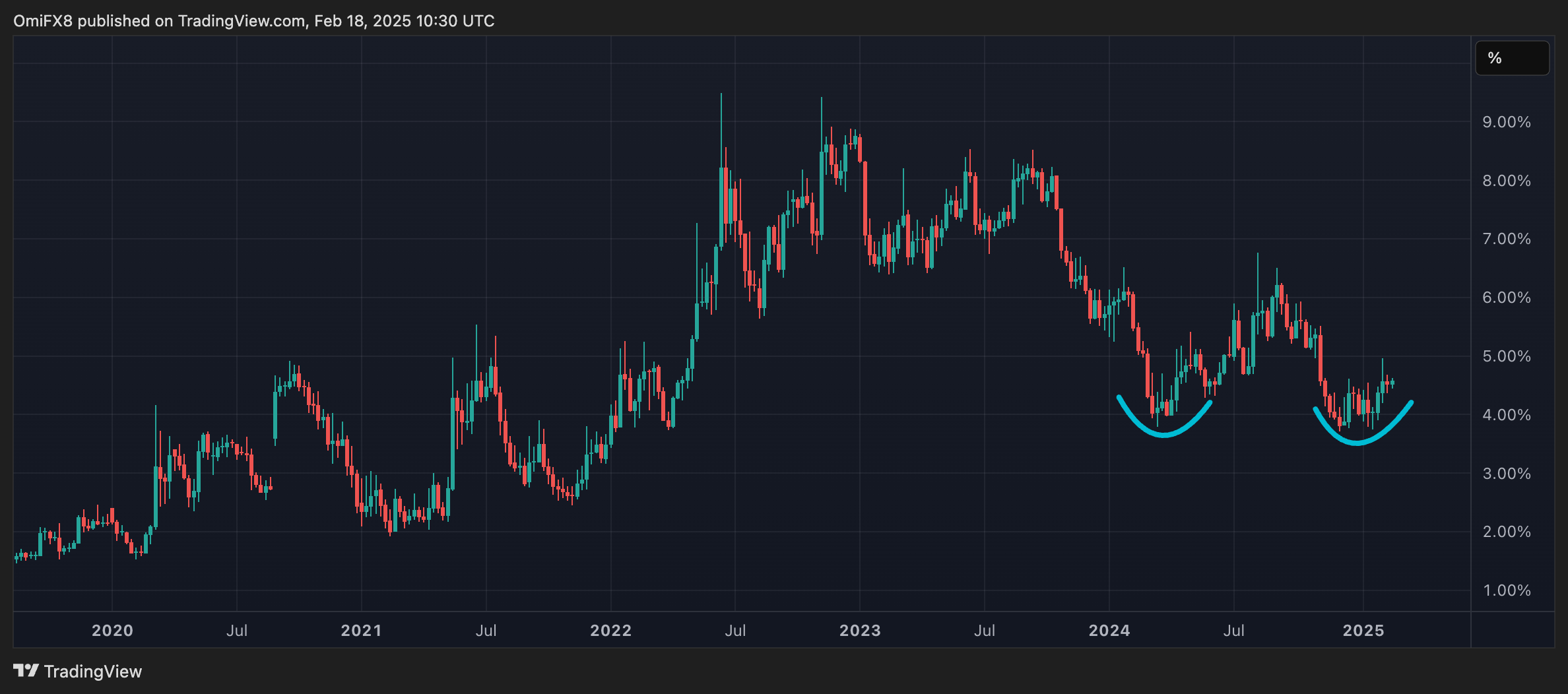
The chart shows the market dominance of Tether’s USDT, the largest dollar-pegged stablecoin.
Its dominance rate seems to have bounced off the March 2024 low, teasing a bullish double bottom pattern.
In other words, USDT could become more dominant, which usually happens during market-wide price corrections.
Crypto Equities
MicroStrategy (MSTR): closed on Friday at $337.73 (+3.94%), down 0.6% at $335.76 in pre-market.
Coinbase Global (COIN): closed at $274.31 (-7.98%)
Galaxy Digital Holdings (GLXY): closed at C$27.65 (-2.54%)
MARA Holdings (MARA): closed at $16.90 (-0.06%)
Riot Platforms (RIOT): closed at $12.27 (+0.33%)
Core Scientific (CORZ): closed at $12.51 (-0.24%)
CleanSpark (CLSK): closed at $10.50 (-1.59%)
CoinShares Valkyrie Bitcoin Miners ETF (WGMI): closed at $23.40 (+0.52%)
Semler Scientific (SMLR): closed at $49.67 (+0.44%)
Exodus Movement (EXOD): closed at $50.00 (unchanged)
ETF Flows
The data below is as of Feb. 14. U.S. markets were closed on Feb. 17.
Spot BTC ETFs:
Daily net flow: $70.6 million
Cumulative net flows: $40.12 billion
Total BTC holdings ~ 1.180 million.
Spot ETH ETFs
Daily net flow: $11.7 million
Cumulative net flows: $3.15 billion
Total ETH holdings ~ 3.791 million.
Source: Farside Investors
Overnight Flows
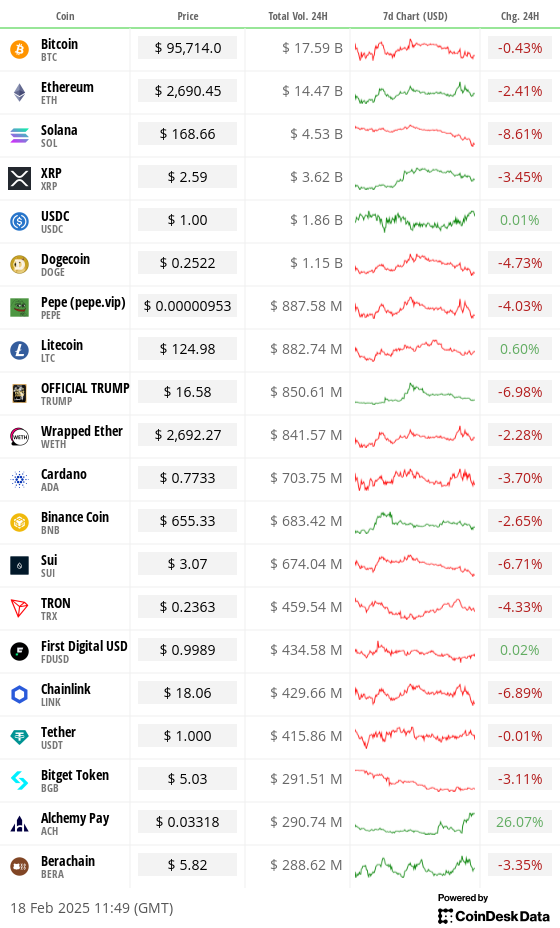
Chart of the Day
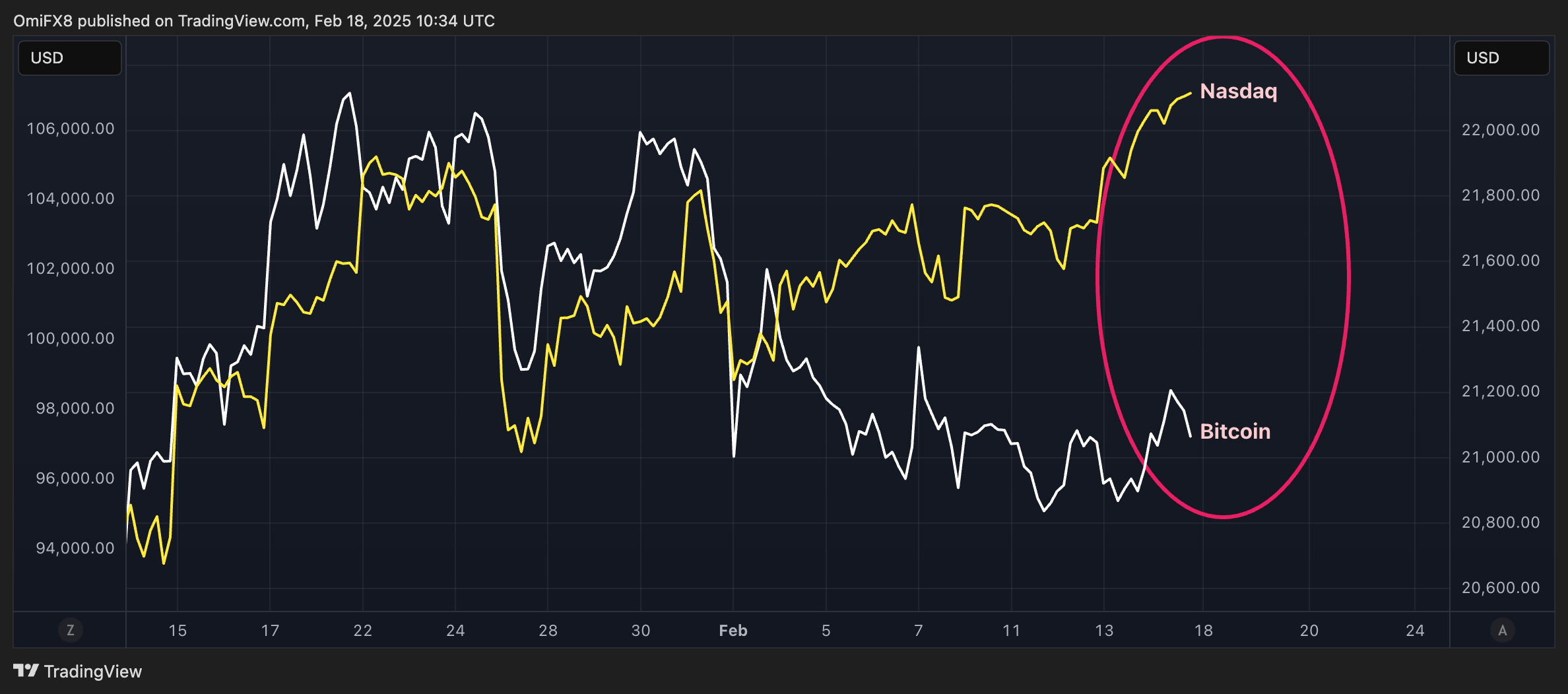
While bitcoin remains listless below $100,000, Wall Street’s tech-heavy Nasdaq 100 has jumped close to record highs.
If BTC’s historical positive correlation with the tech stock is any guide, BTC could soon pick up a strong bid.
While You Were Sleeping
Bitcoin Is Coiled Like a Spring, a Breakout of This Range Is Coming: Van Straten (CoinDesk): Bitcoin has traded in the $91K–$109K range since late November. According to Glassnode, BTC’s 2-week realized volatility has fallen to just 32% on an annual basis.
Ether ETFs Register $393M in Inflows This Month as Crypto Investors Turn Their Back on Bitcoin (CoinDesk): Data on U.S. spot ETFs shows investors pivoting their attention to ether from bitcoin. Analysts say they expect ETH to rise as Ethereum’s Pectra upgrade draws closer.
Milei Denies Wrongdoing in His First Defense of Crypto Debacle (Bloomberg): Argentina’s President Javier Milei defended his promotion of a memecoin called libra — which spiked before crashing — as an effort to support economic growth.
Investors Haven’t Been This Pessimistic About Stocks Since 2023 (The Wall Street Journal): A survey shows 47.3% of U.S. investors expect stock price declines over six months — the most bearish sentiment since November — amid trade war and inflation concerns.
U.S. and Russia Meet for Talks on Ukraine War (Reuters): On Tuesday, Russia’s Foreign Minister Sergei Lavrov met U.S. Secretary of State Marco Rubio in Saudi Arabia to discuss ending the war in Ukraine and restoring relations between the two superpowers.
Australia Cuts Interest Rates for First Time in More Than 4 Years (Financial Times): Australia’s central bank cut its cash rate by 0.25 percentage points to 4.10%, providing mortgage relief while signaling caution about future rate cuts amidst economic uncertainty.
In the Ether

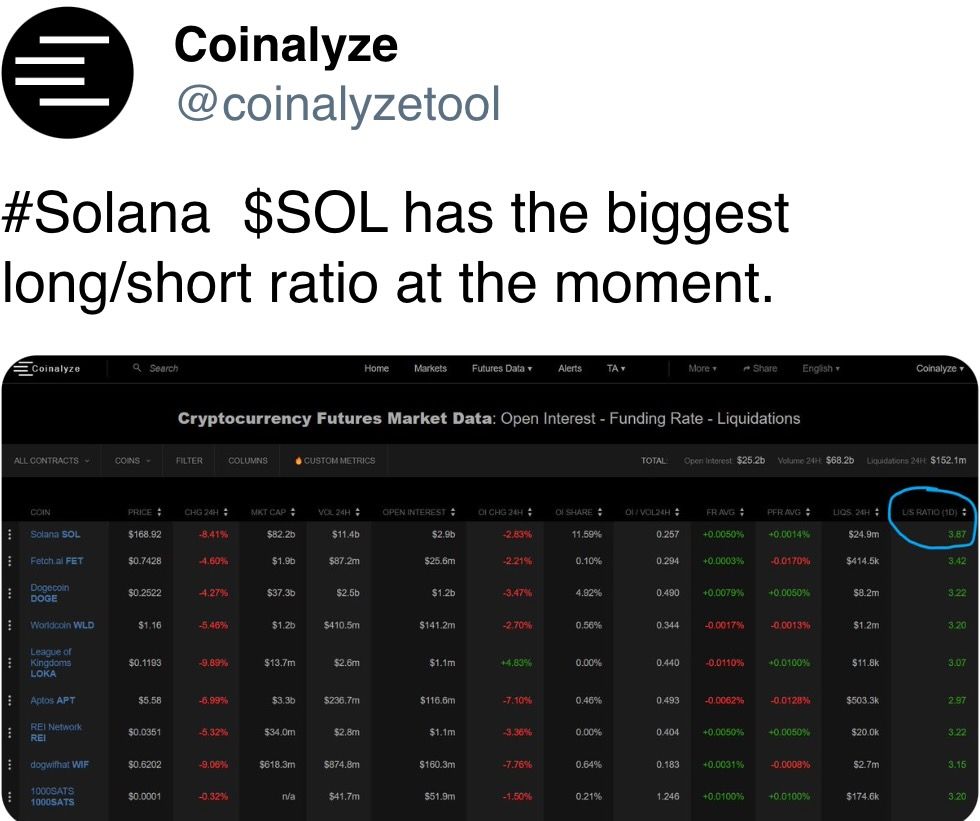
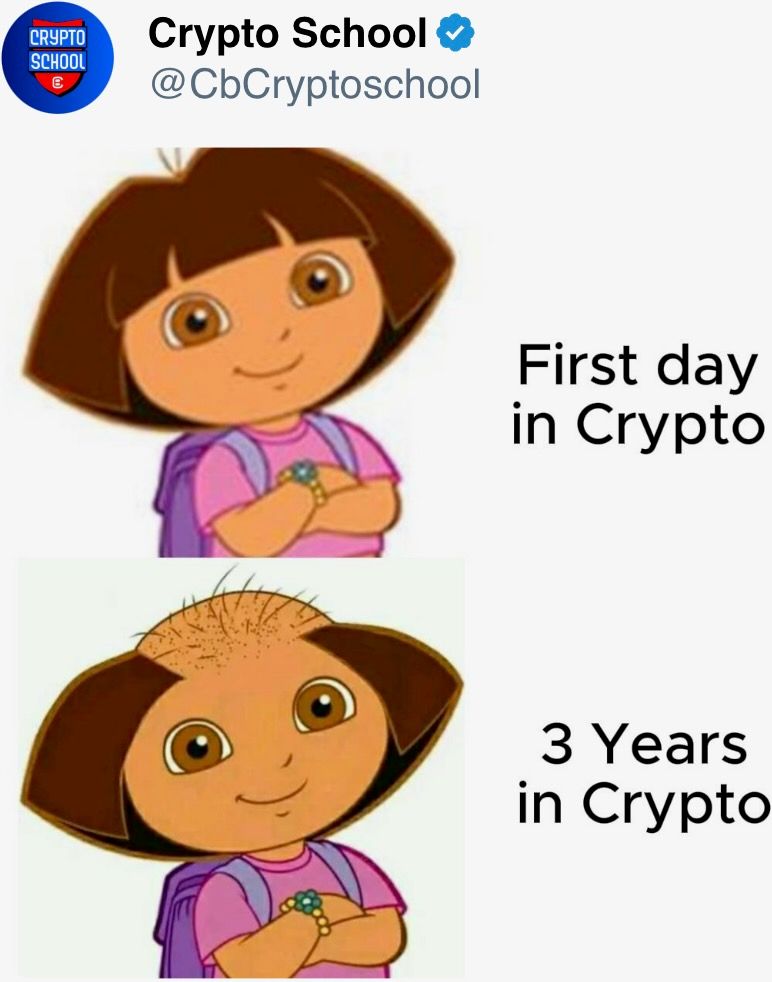

Uncategorized
Bitcoin Mining Profitability Fell in August, Jefferies Says

Bitcoin (BTC) mining profitability declined 5% last month primarily becuase of an increase in the network hashrate, investment bank Jefferies said in a research report Sunday.
«A hypothetical one EH/s fleet of BTC miners would have generated ~$55k/day in revenue during August, vs ~$58k/day in July and ~$44k a year ago,» wrote analysts led by Jonathan Petersen.
The hashrate refers to the total combined computational power used to mine and process transactions on a proof-of-work blockchain, and is a proxy for competition in the industry and mining difficulty. It is measured in exahashes per second (EH/s).
U.S.-listed mining companies mined 3,573 bitcoin in August versus 3,598 in July, the report noted, and these miners accounted for 26% of the Bitcoin network last month, unchanged from July.
MARA Holdings (MARA) mined the most bitcoin of the group, with 705,703 tokens, followed by IREN (IREN), Jefferies said.
MARA’s energized hashrate is still the largest of the group, at 59.4 EH/s, with CleanSpark (CLSK) second with 50 EH/s, the report added.
Read more: Bitcoin Network Hashrate Returned to All-Time Highs in August: JPMorgan
Uncategorized
France, Austria and Italy Urge Stronger EU Oversight of Crypto Markets Under MiCA

Market watchdogs in France, Austria and Italy want the European Union to tighten its approach to crypto regulation, warning that uneven enforcement of the bloc’s landmark MiCA legislation could leave investors exposed to risks that aren’t covered by the rules.
In a joint statement, France’s Autorité des Marchés Financiers (AMF), Austria’s Finanzmarktaufsichtsbehörde (FMA) and Italy’s Consob said the first months of MiCA’s rollout revealed “major differences” in how national supervisors apply the law. Without changes, they argued, firms may shop around for lenient jurisdictions, undermining both investor protection and Europe’s competitiveness in digital assets.
The regulators set out four proposals. Chief among them is handing direct supervision of the largest crypto-asset service providers to the European Securities and Markets Authority (ESMA). They also want to close loopholes allowing EU intermediaries to route orders to offshore platforms not bound by MiCA, a practice that leaves investors without regulatory safeguards.
The authorities also called for mandatory, independent cybersecurity audits before firms receive or renew MiCA licenses, citing the sector’s high exposure to hacks. Finally, they proposed a centralized filing system for token white papers to simplify cross-border offerings and ensure legal clarity.
While MiCA was designed to harmonize crypto oversight across the EU, the three regulators say swift adjustments are needed to align with international standards set by the Financial Stability Board and IOSCO. Without them, they caution, national regulators may be forced into emergency measures that risk fracturing Europe’s digital asset market.
Uncategorized
PayPal Adding Crypto to Peer-to-Peer Payments, Allowing Direct Transfer of BTC, ETH, Others

Payments firm PayPal (PYPL) said it is expanding its peer-to-peer service by adding cryptocurrency transfers to its payment flow, the company announced on Monday.
Users in the U.S. will soon be able to send bitcoin (BTC), ether (ETH), PayPal’s dollar stablecoin PYUSD and other digital assets across PayPal, Venmo and an increasing number of crypto-compatible wallets worldwide, the firm said in a Monday press release.
The integration arrives alongside «PayPal links,» a new tool that lets users generate a one-time personalized link to send or request money. The links can be dropped into text messages, chats or email, embedding payments into everyday conversations.
Personal transfers between friends and family will remain exempt from IRS 1099-K tax reporting requirements, meaning gifts, reimbursements and shared expenses won’t generate tax forms even if crypto is involved in the transaction, the firm said.
The company said the move builds on «PayPal World,» its new interoperability initiative aimed at connecting the largest digital wallets and payment systems. Peer-to-peer payments are a key growth driver, with consumer payment volume climbing 10% in the second quarter year-over-year. In July, the firm said to expand crypto payments for U.S. merchants as part of its deeper push into global digital currency payments.
Read more: PayPal Expands Crypto Payments for U.S. Merchants to Cut Cross-Border Fees
-

 Business11 месяцев ago
Business11 месяцев ago3 Ways to make your business presentation more relatable
-

 Fashion11 месяцев ago
Fashion11 месяцев agoAccording to Dior Couture, this taboo fashion accessory is back
-

 Entertainment11 месяцев ago
Entertainment11 месяцев ago10 Artists who retired from music and made a comeback
-

 Entertainment11 месяцев ago
Entertainment11 месяцев ago\’Better Call Saul\’ has been renewed for a fourth season
-

 Entertainment11 месяцев ago
Entertainment11 месяцев agoNew Season 8 Walking Dead trailer flashes forward in time
-

 Business11 месяцев ago
Business11 месяцев ago15 Habits that could be hurting your business relationships
-

 Entertainment11 месяцев ago
Entertainment11 месяцев agoMeet Superman\’s grandfather in new trailer for Krypton
-

 Entertainment11 месяцев ago
Entertainment11 месяцев agoDisney\’s live-action Aladdin finally finds its stars





